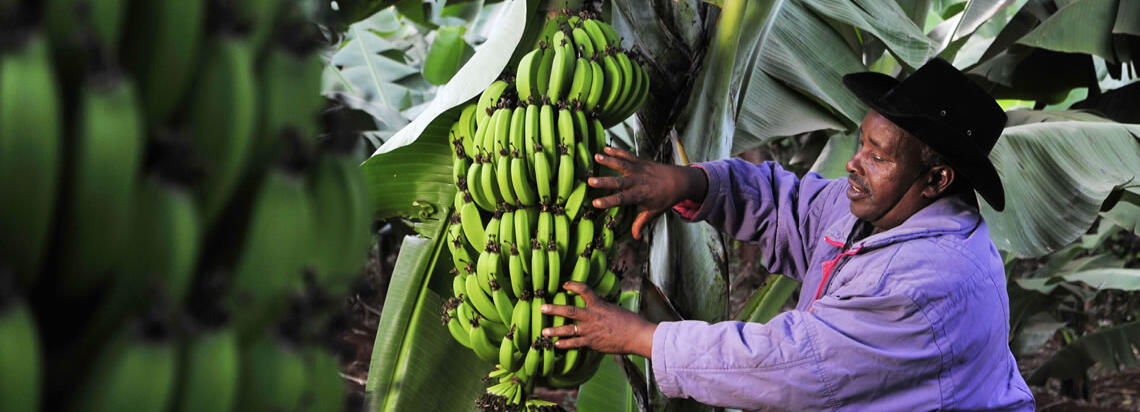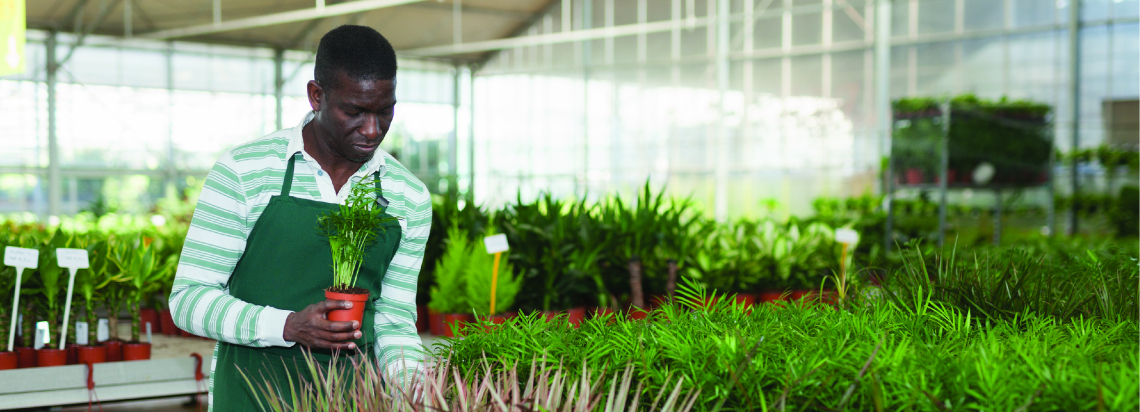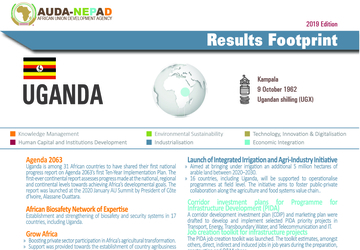 Uganda
Uganda
Official Name: Republic of Uganda
Capital: Kampala
Independence Day: 9 October 1962
Currency: Ugandan shilling (UGX)
Key Result
Uganda is one of the five pilot countries that are refining and contextualizing the Africa Extractives Capacity Assessment Framework (ECAF). These pilots are a major vehicle for domesticating the African Mining Vision.
Uganda is among ten countries where skills audits and youth employment creation studies have been completed. This exercises addressed the Rural Futures Programme’s objective of reducing rural poverty and addressing employment challenges.
The African Women Foundation (AFFRO) received €100,000.00 from the NEPAD Spanish Fund to support asset building for poverty eradication among young women.
Uganda-Kenya Petroleum Products Pipeline is 300 km long pipeline which provides a lower cost mode of transport of petroleum products.
85 Million hectares of land on the continent have been committed for restoration through the application of the restoration opportunities assessment methodology. To-date, Uganda has committed 2.5 million ha.
Uganda received 27.6 million USD from the Global Agriculture and Food Security Programme (GAFSP) to support the government's efforts to explicitly link agriculture, nutrition, health and education through school-based demonstration gardens, nutrition education, and small gardens.
Related
Projects

A critical AU Model Law aimed at harmonizing medical products regulatory systems in Africa was endorsed by African Heads of State and Government at the January 2016 AU Summit in Addis Ababa, Ethiopia. The AU Model Law will contribute towards accelerate the regulation of safe, quality and affordable medical products and technologies in Uganda.
In 2015, the inaugural IGAD Member States NMRA’s meeting was held in Addis Ababa, Ethiopia. Uganda successfully participated and signed the Call for Action to implement a regional Medicines Regulatory Harmonization (MRH) programme. A follow up meeting was convened in 2016 and agreed to establish an IGAD MRH Steering Committee, Technical Working Groups (TWG’s) and a Coordination Unit.
After the successful establishment of the East African Countries (EAC) Medicines Regulatory Harmonization (MRH) programme in 2012, Uganda participated in the development and subsequent adoption of harmonized technical guidelines by the EAC Council in 2014 and publication of a compendium for EAC member states. Two pilot projects: the World Health Organization Medicines Prequalification Program (WHO-PQP) and the EAC Joint Assessments and Inspections ensured that Uganda participated in the approval of 5 and 7 products in 2011 and 2013 respectively. Phase two of the EAC-MRH programme has expanded to include drug safety (pharmacovigilance) strengthening; clinical trials oversight; regulation and quality assurance of medical devices including diagnostics; and harmonization of regulation of vaccines. In 2015, the EAC-MRH programme conducted a Joint Dossier Assessment of 8 medicinal products in Entebbe, Uganda.
The National Drug Authority of Uganda is a designated RCORE specialized in licensing of the manufacture, import, export, distribution and; inspection and surveillance of manufacturers, importers, wholesalers and dispensers of medicines. RCOREs are institutions with specific academic and technical regulatory science expertise and training capabilities capable of producing regulatory workforce in Africa.

Measuring the Cost of Hunger in Africa: This study was completed in 4 countries (Egypt, Ethiopia, Swaziland and Uganda). The overarching objective of the multi-country study led by the AUC, NEPAD, WFP and UNECA, is to catalyse coordinated action and inform the design of nutrition-oriented policy frameworks and programmes, with greater investments to eradicate child undernutrition on the continent.
10 findings from the first phase of the “Measuring the Cost of hunger” study:
- There are more stunted children in Africa today than there were 20 years ago.
- 69 to 82 per cent of all cases of child undernutrition are not properly treated.
- Most of the health costs associated with undernutrition occur before the child turns one year old
- 4 between 7 and 16 per cent of grade repetitions at schools are associated with stunting.
- Stunted children complete 0.2 to 1.2 years less in school education.
- 8 to 28 per cent of all child mortality is associated with undernutrition.
- Child mortality associated with undernutrition has reduced national workforces by between 1 and 8 per cent
- 40 to 67 per cent of working-age populations suffered from stunting as children.
- The annual costs associated with child undernutrition reach values equivalent to 1.9 to 16.5 per cent of gross domestic product.
- Eliminating stunting in africa is a necessary step for inclusive development on the continent.

CAADP Compact: Uganda signed the CAADP Compact on 30 - 31 March 2010 and organised its independent technical review for the 2–10 September the same year. A business meeting was held from 16-17 September 2010.
Agriculture Risk Assessment: For Uganda, an Agricultural Risk Assessment was undertaken, highlighting the major risks in the agricultural sector, including plant and animal pests and diseases, price and market volatility, fake inputs, post-harvest losses, and drought spells. Mitigation and adaptation tools will be developed in 2016.
National Agricultural Investment Plan: Analytical work and country stocktaking were conducted for its NAIP implementation and impacts.
Funding: Uganda received funding from the Global Agriculture and Food Security Programme (GAFSP) to a tune of USD 27.64 million. The funding finances interventions that seek to link agriculture, nutrition, health and education in order to improve food security and nutrition outcomes among vulnerable groups in the country.
AGRIBUSINESS AND AGRIFINANCE Project - Click here for more information

Project : TAH programme
Description : This is phase I of the continental connectivity programme that focuses on completion and standardisation of the TAH missing links by 2030
Project : Single African Sky phase 1 (design and initial implementation)
Description : Single African Sky is a continental programme that will create a high-level, satellite-based air navigation system for the African continent
Project : Yamoussoukro Decision implementation
Description : Accelerate Yamoussoukro Decision implementation by identifying countries that are ready to fully implement it, and discussing and agreeing with both their governments and airlines to launch the voluntary club on a full membership basis;
Project : ICT Enabling Environment
Description : This programme would improve the environment for the private sectors to invest in high-speed broadband infrastructure
Project : ICT Terrestrial for Connectivity
Description : This programme has two main components: secure each country connection by at least two broadband infrastructure and ensure the access to submarine cable to all landlocked countries
Project : Internet Exchange Point (IXP) programme
Description : The aim of this programme is to provide Africa with adequate internet node exchange to maximise internal traffic
Project : Uganda-Kenya Petroleum Products Pipeline
Description : 300 km long pipeline for a lower cost mode of transport of petroleum products
Project : Northern Multimodal Corridor
Description : This programme is designed to modernize the highest priority multimodal ARTIN corridor on modern standards (climbing lanes and urban bypasses) in East Africa. This programme aims to facilitate travel by people and goods across the borders between Kenya, Uganda, Rwanda,Burundi and DRC with a spur to South Sudan
Project : Central Corridor
Description : This programme would modernize the third priority ARTIN corridor in East Africa and facilitate travel for people and goods across the borders between Tanzania, Uganda, Rwanda, Burundi and DRC
Project : Lamu Gateway Development
Description : This programme aims at responding to the Eastern Africa challenge in developing sufficient port capacity to handle future demand from both domestic sources and landlocked countries. The priority action will be to develop the Lamu gateway
Project : Kampala Jinja Road Upgrading (DFS)
Description : Improvement of the traffic capacity of Greater Kampala; this road corridor is a vital link connecting Juba, South Sudan with Kampala, Uganda. Given its design configuration as a dual carriageway of 2 to 4 lanes in each direction, this project could potentially be procured through PPP.



The basis for policy formulation and implementation regarding genetically modified (GM) crops was strengthened among Members of Parliament from Uganda through information and real-life experience of small-scale farmers in South Africa.
Technical capacities were strengthened to establish and manage functional biosafety systems for the safe use of modern agricultural biotechnology. Other technical support included national biosafety training workshops, biosafety short courses at African institutions and partner institutions outside Africa, notably at Michigan State University in the USA, biosafety internships, technical consultation support, and biosafety information resources.
Biosafety short courses form an integral component of ABNE activities in Africa. In 2014, ABNE presented a biosafety short course at Makerere University in Uganda and agricultural biotechnology short courses at Michigan State University in the USA. A total of 24 regulators drawn from Ethiopia, Kenya, Malawi, Mozambique, Tanzania, Uganda and Zimbabwe gained broad insights into the basics of biosafety science, policy and regulation, GM crop risk assessment and management, and biosafety communication and awareness creation.
Results:
Enhancing income growth between small and micro women entrepreneurs through use of ICT - Women of Uganda Network (WOUGNET)
The capacity and income generation of 150 women small and micro women entrepreneurs enhanced through the use of ICT

Enhancing Agricultural climate change planning
• Coping strategies identified to deal with the effect of climate change on Agriculture in Wakiso, Mbarara and Lira Districts.
• Tool kit on adaptation to climate change produced and distributed
• Tool kit on adaptation to climate change produced, translated in local language and distributed
• Sensitization and capacitation of 80 District Chief Administrative Officers, District planners, farmers and Agricultural extension workers/Production coordinators on how to deal with the effects of Climate change on Agriculture.
• Transfer of Green technologies in the form of Solar powered Eco stoves to 39 households
Developed Tool kit for communities to use for adaptation and responding to Climate change in agriculture

The ASTII project was launched in the country in September 2007. Implementation of the project saw R&D data collected and subsequently published in the 1st African Innovation Outlook (AIO-2010) report. Moreover, data for both R&D core indicators and Innovations was published in the 2nd AIO report of 2014.
The country established a dedicated Council to manage STI indicators in Uganda - the Uganda National Council for Science and Technology, (UNCST).
Uganda benefited from regional training workshops that were conducted by the NEPAD/ASTII Team, the UNESCO Institute for Statistics, the South Africa’s Centre for Science, Technology and Innovation Indicators (CeSTII) and the Research Policy Institute of the University of Lund, held between 2008 and 2012 on international survey methodologies (OECD).
The country signed two NEPAD grant agreements for financial support to STI surveys from the SIDA seed funding instrument, to tune of USD75,000 covering the period 2008 to 2013.
Contact: Mr. Richard Lutalo (luahengo@ncrst.na), Senior Science Officer, Head of STI Statistics, STI Policy Development and Coordination.
Website: http://www.ncrst.na

Results (2013 – 2015)
Programme for Enhancing Use of Country Results Frameworks:
• In-country Visits have commenced
• Secured funding for the initiative for the next two (2) years
Development and Piloting of an Africa Extractives Capacity Assessment Framework (ECAF):
• the Africa Mineral Development Centre (AMDC) that is driving the AU Africa Mining Vision (AMV);
• Successful selection and buy-in from the five (5) pilot countries initially selected to refine and contextualize the Framework. The pilot countries are Democratic Republic of Congo, Ghana, Mozambique, Kenya and Uganda;
• In-country capacity assessments successfully carried out in 4 countries towards ensuring the countries effectively utilize the instrument so as to develop and deploy requisite capacities required to achieve the Africa Mining Vision with emphasis on “Mining for Development”;
• The Framework is a practical tool that can be used by other sectors to identify essential capacities (Human, Institutional and Evidence-based knowledge) to ensure effective delivery and impact of the particular sector towards sustainable economic growth.
Advocacy and Strengthening of Negotiation Capacities on Post-2015 Development Agenda through the Common African Position (CAP):
• The multi-stakeholder framework of engagement specifically enhanced dialogue towards ensuring the required mass to influence the Post-2015 Global Agenda and Development Goals relevant to the Continent;
• This intervention helped strengthen country and regional level negotiating capacities for the effective incorporation and articulation of Africa’s priorities as enshrined in CAP in the final Global SDGs;
• The project enabled the participation of African stakeholders at the Means of Implementation Engagement, 3rd Financing for Development Conference and the UN General Assembly that adopted the new SDGs. This ensured the incorporation of Africa’s development priorities into the new goals through developing essential negotiation capacities;
• Through the CAP/SDGs space on the Africa Platform for Development Effectiveness (APDev), knowledge products and negotiation documents, as well as, policy briefs where successfully disseminated to the African negotiators in New York and kept the continent’s stakeholders informed of the overall process;
• Development and dissemination of post-2015 Policy Briefs on “Financing and Partnerships” and “Structural Economic Transformation and Inclusive Growth”. These are priorities outlined in the CAP and the policy briefs where utilized in the negotiation process for the African continent.
Global Partnership for Effective Development Cooperation (GPEDC):
• Africa secured the hosting of the 2nd High Level Meeting (HLM) of the Global Partnership. This was attained through robust negotiation and facilitating a common voice from Africa with regards to this critical engagement by the NEPAD Agency. The 2nd HLM will be held in Nairobi Kenya;
• The NEPAD Agency advocated for the full inclusion and participation of Africa’s Regional Economic Communities (RECs) in conducting the 2nd GP Monitoring Exercise. This was a fundamental achievement considering the RECs are the continent’s building blocks with regards to socio-economic transformation;
• The Africa Action Plan on Development Effectiveness (AAP) was granted the status of an official Global Partnership Initiative (GPI) at the Planning Meeting in Brussels. The AAP was developed by the NEPAD Agency in consultation with African multi stakeholders. This has enabled the Agency to successfully mobilize resources towards the implementation of the AAP.

Project : Geothermal – Baringo-Silali Geothermal Field Project
Countries/Region : Kenya, Uganda, Rwanda | East Africa
Project Location : Kenyan part of the East African Rift (extending from Baringo to Silali up to the border
with Ethiopia)
Sector/Subsector : Energy/Generation
Project Description : Development of geothermal energy in the Baringo-Silali Block, which comprises the Bogoria, Baringo, Arus, Korosi, Chepchuk, Paka, and Silali prospects.
Project : Transmission-- North South Transmission Line Project
Countries/Region : Egypt, Sudan, South Sudan, Ethiopia, Kenya, Uganda, Tanzania, Malawi,Mozambique, Zambia, Zimbabwe, South Africa, | East and Southern Africa
Project Location : Regional Interconnector-East and Southern Africa
Sector/Subsector : Energy/Transmission
Project Description : Construction of an 8,000 km, 3,000 - 17,000 MW capacity transmission line system from Egypt through Sudan, South Sudan, Ethiopia, Kenya, Uganda, Tanzania, Malawi, Mozambique, Zambia, and Zimbabwe to South Africa, connecting the Eastern Africa Power Pool (EAPP) and the SAPP.

Description : The use of political gravitas and goodwill to unblock and facilitate political bottlenecks affecting the implementation of ICT broadband and optic fibre projects on the continent


"New Alliance for Food security and Nutrition and Grow Africa Partnerships: 25 LOIs from 12 domestic companies and 13
international.
• $963,285,545 of planned investment.
• $3,710,392 reported as invested in 2014, making
a cumulative total of $112,994,692 to date.
• 551,417 smallholders reached in 2014.
• 1,390 jobs created in 2014.
• $218 million donor disbursements in 2014 (84 %
of expected)."

- Through the support of the TerrAfrica Leveraging Fund (TLF), Uganda was able integrate SLWM into the national environmental and agricultural frameworks through the development of SLM Country Strategic Investment Frameworks (CSIF) and has completed its analyses on the costs and benefits of SLM options.
- Strategic Investment Program (SIP): The Strategic Investment Framework for Sustainable Land Management (U-SIF SLM) for Uganda aims to promote key sector cooperation towards improving natural resource based livelihoods and other ecosystem services. The U-SIF SLM is a multi-sector national initiative to be spearheaded by the Ministry of Agriculture Animal Industry and Fisheries (MAAIF) – the focal ministry for the UNCCD, CAADP and TerrAfrica.


At the beginning of 2014, 37 of the 42 opted-in African countries have completed a rapid assessment / gap analysis. The next step for countries is to develop a SE4LL Action Agenda and Investment Prospectus(es). To support this process, the SE4ALL Africa Hub partners have led the development of Africa Guidelines for SE4ALL national Action Agendas. The Africa Guidelines lay out principles and process for developing Action Agendas and put forward a balanced approach of centralized and decentralized solutions to achieve universal access to energy services.
Progress in Uganda:
SE4All Action Agenda has been finalised"

The Uganda Agriculture Risk Assessment study was undertaken, highlighting the major risks in the agriculture sector, including plant and animal pests and diseases, price and market volatility, fake inputs, post-harvest losses, and drought spells. The attendant tools and policy instruments for mitigation and adaptation will be developed in 2016.
This will entail providing support to technical and financial institutions who will provide at least 100,000 farmers (by end of 2017) with AFIRM Tools – including insurance schemes on selected crops, agriculture and market information, storage facilities for reducing post-harvest losses and productive safety nets.
you agree to the AUDA-NEPAD Privacy Policy.



